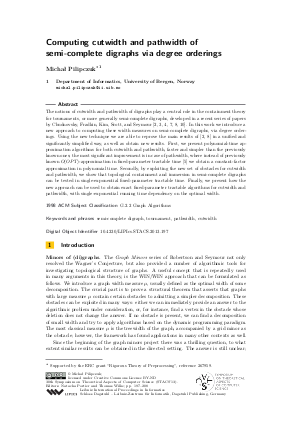Computing cutwidth and pathwidth of semi-complete digraphs via degree orderings
Author Michal Pilipczuk
-
Part of:
Volume:
30th International Symposium on Theoretical Aspects of Computer Science (STACS 2013)
Part of: Series: Leibniz International Proceedings in Informatics (LIPIcs)
Part of: Conference: Symposium on Theoretical Aspects of Computer Science (STACS) - License:
 Creative Commons Attribution-NoDerivs 3.0 Unported license
Creative Commons Attribution-NoDerivs 3.0 Unported license
- Publication Date: 2013-02-26
File

PDF
LIPIcs.STACS.2013.197.pdf
- Filesize: 0.58 MB
- 12 pages
Document Identifiers
Subject Classification
Keywords
- semi-complete digraph
- tournament
- pathwidth
- cutwidth
Metrics
- Access Statistics
-
Total Accesses (updated on a weekly basis)
0PDF Downloads0Metadata Views
Abstract
The notions of cutwidth and pathwidth of digraphs play a central role in the containment theory for tournaments, or more generally semi-complete digraphs, developed in a recent series of papers by Chudnovsky, Fradkin, Kim, Scott, and Seymour (Maria Chudnovsky, Alexandra Fradkin, and Paul Seymour, 2012; Maria Chudnovsky, Alex Scott, and Paul Seymour, 2011; Maria Chudnovsky and Paul D. Seymour, 2011; Alexandra Fradkin and Paul Seymour, 2010; Alexandra Fradkin and Paul Seymour, 2011; Ilhee Kim and Paul Seymour, 2012). In this work we introduce a new approach to computing these width measures on semi-complete digraphs, via degree orderings. Using the new technique we are able to reprove the main results of (Maria Chudnovsky, Alexandra Fradkin, and Paul Seymour, 2012; Alexandra Fradkin and Paul Seymour, 2011) in a unified and significantly simplified way, as well as obtain new results. First, we present polynomial-time approximation algorithms for both cutwidth and pathwidth, faster and simpler than the previously known ones; the most significant improvement is in case of pathwidth, where instead of previously known O(OPT)-approximation in fixed-parameter tractable time (Fedor V. Fomin and Michal Pilipczuk, 2013) we obtain a constant-factor approximation in polynomial time. Secondly, by exploiting the new set of obstacles for cutwidth and pathwidth, we show that topological containment and immersion in semi-complete digraphs can be tested in single-exponential fixed-parameter tractable time. Finally, we present how the new approach can be used to obtain exact fixed-parameter tractable algorithms for cutwidth and pathwidth, with single-exponential running time dependency on the optimal width.
Cite As Get BibTex
Michal Pilipczuk. Computing cutwidth and pathwidth of semi-complete digraphs via degree orderings. In 30th International Symposium on Theoretical Aspects of Computer Science (STACS 2013). Leibniz International Proceedings in Informatics (LIPIcs), Volume 20, pp. 197-208, Schloss Dagstuhl – Leibniz-Zentrum für Informatik (2013)
https://doi.org/10.4230/LIPIcs.STACS.2013.197
BibTex
@InProceedings{pilipczuk:LIPIcs.STACS.2013.197,
author = {Pilipczuk, Michal},
title = {{Computing cutwidth and pathwidth of semi-complete digraphs via degree orderings}},
booktitle = {30th International Symposium on Theoretical Aspects of Computer Science (STACS 2013)},
pages = {197--208},
series = {Leibniz International Proceedings in Informatics (LIPIcs)},
ISBN = {978-3-939897-50-7},
ISSN = {1868-8969},
year = {2013},
volume = {20},
editor = {Portier, Natacha and Wilke, Thomas},
publisher = {Schloss Dagstuhl -- Leibniz-Zentrum f{\"u}r Informatik},
address = {Dagstuhl, Germany},
URL = {https://drops.dagstuhl.de/entities/document/10.4230/LIPIcs.STACS.2013.197},
URN = {urn:nbn:de:0030-drops-39340},
doi = {10.4230/LIPIcs.STACS.2013.197},
annote = {Keywords: semi-complete digraph, tournament, pathwidth, cutwidth}
}
